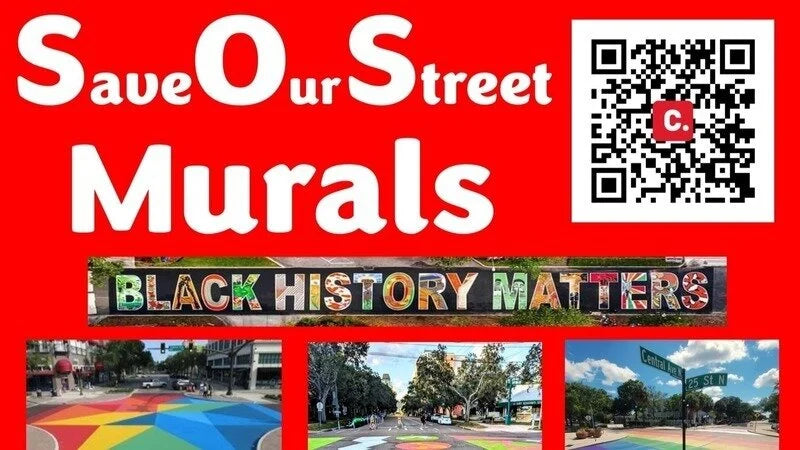
St. Pete’s Art Under Fire: St. Pete’s Colorful Streets Face a State-Ordered Makeover
Share
State Directive Puts Murals in the Crosshairs
On June 30th 2025, the Florida Department of Transportation (FDOT) sent a memorandum to municipalities banning pavement art that contains social, political, or ideological imagery on travel lanes, paved shoulders, intersections, crosswalks, and sidewalks. The directive began making headlines and sparking public debate in early July. Cities that fail to comply could lose state transportation funding.
The policy specifically targets some of St. Petersburg’s most recognizable public art, including the “Progressive Pride” crosswalks in the Grand Central District and the “Black History Matters” mural near the Woodson African American Museum.
This is not only about aesthetics. Studies from groups like Bloomberg Philanthropies’ Asphalt Art Initiative show that painted intersections and crosswalks can slow traffic and improve safety. In fact, research found that 15 of 17 sites with asphalt art saw either a decrease in crashes or no increase at all. For a city like St. Pete, where walkability and artistic identity are intertwined, the issue is about how public space is defined and who gets to decide.
Petition Pushes Back Against Erasure
On August 2nd 2025, St. Pete Pride co-founder and LGBTQ+ advocate Brian Longstreth launched a petition titled Save Our Street Murals. Within just a few days, it gathered more than 200 signatures. Longstreth has stressed that these works are more than decorations—they are cultural landmarks that represent inclusion and community pride. The petition calls on city leaders to resist the state directive and protect the murals that have become part of St. Pete’s identity.
City officials have received strong community backing. Councilmember Gina Driscoll has voiced support for keeping the murals in place, noting they also function as safety features by slowing drivers and improving pedestrian visibility. She has said the city should make a strong case to preserve them for both cultural and safety reasons.
How the City Plans to Fight Back
In response to FDOT’s demands, St. Petersburg is compiling a complete inventory of painted infrastructure to submit to the state. Officials are also exploring whether certain works could qualify for exemptions—particularly those that can be tied to pedestrian and traffic safety benefits.
Advocates argue that these murals are more than public art—they are integral to the city’s character. They serve as community gathering points, boost tourism, and act as visible markers of inclusion. Losing them would erase cultural expression while undermining the city’s efforts to make its streets safer and more welcoming.
More Than Just Paint on Pavement

This fight touches every layer of civic life. From a safety perspective, mural-enhanced crosswalks have been shown to slow vehicles and protect pedestrians. Culturally, the art reflects the inclusive, creative spirit that has made St. Petersburg known as a “City of the Arts.” From a community standpoint, the fast-growing petition shows residents value public expression and will not accept state-level mandates that strip it away.
This is not just about paint—it’s about a community’s right to decide how its public spaces look and feel. For many residents, these murals stand as symbols of belonging, representation, and civic pride.
The Public’s Role in the Outcome
St. Petersburg has built its reputation on being bold and unapologetically creative. That spirit is now being tested. Residents who want the murals to remain are encouraged to sign the petition, share the cause on social media, and contact local officials to voice their support.
This movement is about more than saving artwork—it’s about making sure the streets of St. Pete reflect the people who walk them every day. As Councilmember Driscoll has said, the city isn’t going anywhere. Neither should its art.
